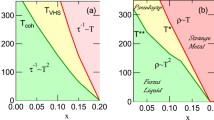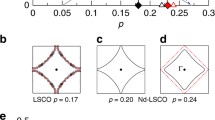Abstract
We discuss a short-range order mechanism for understanding pseudogap physics of cuprates in which the competition between a variety of magnetic orders frustrates the development of the long-range order. We show in particular that the competition between the effects of Van Hove singularity nesting and conventional Fermi surface nesting leads to a material-dependent transition between Mott and Slater physics, and the emergence of a spin-frustrated state in the crossover region.




Similar content being viewed by others
References
Moriya, T.: Spin Fluctuations in Itinerant Electron Magnetism. Springer, Berlin (1985)
Markiewicz, R.S., Buda, I.G., Mistark, P., Bansil, A.: Entropic origin of pseudogap physics and a Mott-Slater transition in cuprates. Sci. Repts. 7, 44008 (2017)
Ornstein, L.S., Zernike, F.: Accidental deviations of density and opalescence at the critical point of a single substance. Proc. Acad. Sci. Amsterdam 17, 793–806 (1914)
Hertz, J.A.: Quantum critical phenomena. Phys. Rev. B 14, 1165–1184 (1976)
Millis, A.J.: Effect of a nonzero temperature on quantum critical points in itinerant fermion systems. Phys. Rev. B 48, 7183–7196 (1993)
Markiewicz, R.S.: Mode-coupling model of Mott gap collapse in the cuprates: natural phase boundary for quantum critical points. Phys. Rev. B 70, 174518 (2004)
Mermin, N.D., Wagner, H.: Absence of ferromagnetism or antiferromagnetism in one- or two-dimensional isotropic Heisenberg models. Phys. Rev. Lett. 17, 1133–1136 (1966)
Ouazi, S., et al.: Impurity-induced local magnetism and density of states in the superconducting state of YBa2Cu3O7. Phys. Rev. Lett. 96, 127005 (2006)
Alloul, H., Gabay, J., Bobroff, M., Hirschfeld, P.: Defects in correlated metals and superconductors. Rev. Mod. Phys. 81, 45 (2009)
Labbé, J., Barisić, S., Friedel, J.: Strong-coupling superconductivity in V3X type of compounds. Phys. Rev. Lett. 19, 1039 (1967)
Marsiglio, F.: This conference
Jelitto, R.: The density of states of some simple excitations in solids. J. Phys. Chem. Sol. 30, 609 (1969)
Jarlborg, T., Bianconi, A.: Breakdown of the Migdal approximation at Lifshitz transitions with giant zero-point motion in the H3S superconductor. Sci. Rep. 6, 24816 (2016)
Mazziotti, M.V., Valletta, A., Campi, G., Innocenti, D., Perali, A., Bianconi, A.: Possible Fano resonance for high- T c multi-gap superconductivity in p-Terphenyl doped by K at the Lifshitz transition. EPL (Europhysics Letters) 118, 37003 (2017)
Aeppli, G., Mason, T.E., Hayden, S.M., Mook, H.A., Kulda, J.: Nearly singular magnetic fluctuations in the normal state of a high- T c cuprate superconductor. Science 278, 1432–1435 (1997)
Anderson, P.W.: Is there glue in cuprate superconductors? Science 316, 1705 (2007)
Maier, T.A., Poilblanc D., Scalapino, D.J.: Dynamics of the pairing interaction in the Hubbard and t-J models of high-temperature superconductors. Phys. Rev. Lett. 100, 237001 (2008)
Rice, T.M., Yang, K.-Y., Zhang, F.C.: A phenomenological theory of the anomalous pseudogap phase in underdoped cuprates. Rep. Prog. Phys. 75, 016502 (2012)
Jang, S.W., et al.: Direct theoretical evidence for weaker correlations in electron-doped and Hg-based hole-doped cuprates. Sci. Rep. 6, 33397 (2016)
Mistark, P., Markiewicz, R.S., Bansil, A.: Nanoscale phase separation in deeply underdoped Bi2Sr2CuO6 + δ and Ca2CuO2Cl2. Phys. Rev. B 91, 140501(R) (2015)
Imada, M., Fujimori, A., Tokura, Y.: Metal-insulator transitions. Rev. Mod. Phys. 70, 1039 (1998)
Acknowledgements
Part of this work was carried out while RSM was on sabbatical at the Advanced Light Source in Berkeley and the Los Alamos National Laboratory, where he benefitted from many discussions.
Author information
Authors and Affiliations
Corresponding author
Additional information
This work is supported by the US Department of Energy, Office of Science, Basic Energy Sciences grant number DE-FG02-07ER46352, and benefited from Northeastern University’s Advanced Scientific Computation Center (ASCC) and the allocation of supercomputer time at NERSC through grant number DE-AC02-05CH11231.
Rights and permissions
About this article
Cite this article
Markiewicz, R.S., Buda, I.G., Mistark, P. et al. A New Model of Pseudogap Physics in the Cuprates. J Supercond Nov Magn 31, 651–655 (2018). https://doi.org/10.1007/s10948-017-4361-5
Received:
Accepted:
Published:
Issue Date:
DOI: https://doi.org/10.1007/s10948-017-4361-5




